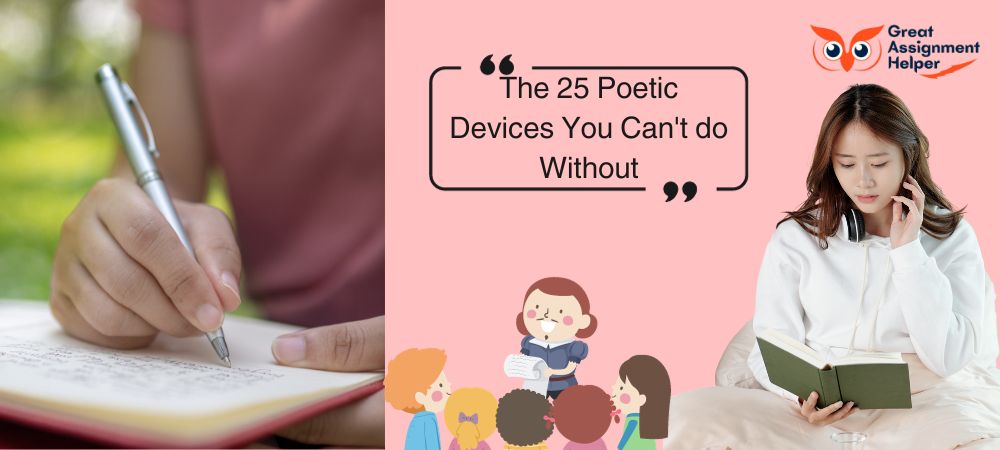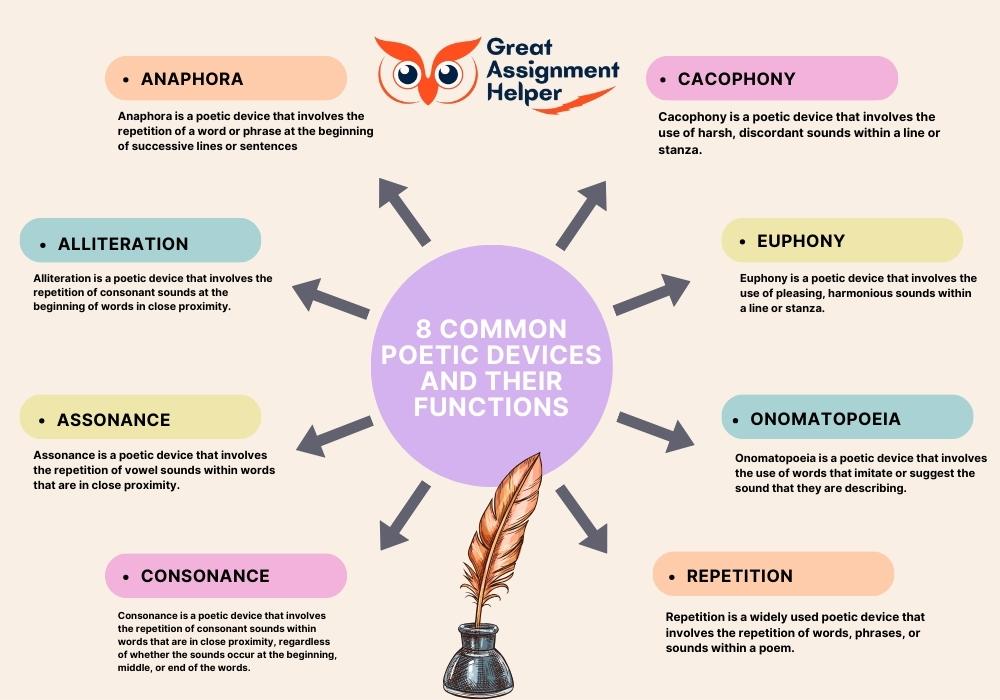
Listen To This Blog
Why Poetic Devices Matter
Poetic devices are the secret weapons of every great poet. They are the tools that allow poets to create powerful, captivating, and memorable works of art. These devices add depth, beauty, and complexity to poetry, making it more than just a string of words on a page.
From the rhythmic repetition of anaphora to the musicality of alliteration, poetic devices bring a poem to life. They engage our senses, evoke emotions, and paint vivid pictures in our minds. Without these devices, poetry would be bland and forgettable.
Whether you're a literature student or simply someone who appreciates the beauty of language, understanding and appreciating these twenty-five poetic devices will enhance your reading experience. So, let's delve into the world of poetic devices and discover the magic they bring to the written word.
Understanding Poetic Devices
Poetic devices are tools used by poets to enhance the meaning and impact of their poetry. They are techniques and literary devices that add layers of complexity and beauty to a poem. These devices include anaphora, alliteration, assonance, consonance, cacophony, euphony, onomatopoeia, repetition, rhyme, caesura, allusion, analogy, hyperbole, irony, imagery, oxymoron, paradox, pun, personification, euphemism, enjambment, zeugma, blank verse, meter, allegory, epistrophe, metonymy, and synecdoche. Each device has its own unique effect, such as creating rhythm, emphasizing certain words or ideas, creating vivid imagery, or adding depth and complexity to the meaning of the poem. Understanding and recognizing these devices can help readers appreciate and analyze poetry more effectively.
The impact of Poetic Devices of Poetry
The impact of poetic devices on poetry is profound. These devices have the power to transform a simple poem into a masterpiece. They evoke emotions, create imagery, and convey complex ideas in a way that is both captivating and memorable. Poetic devices add depth and richness to the written word, allowing readers to engage with the poem on a deeper level. They create rhythm and musicality, drawing us in and holding our attention. They emphasize certain words or ideas, making them stand out and leaving a lasting impression. Poetic devices are the tools that enable poets to express their thoughts and feelings in a way that is both artistic and impactful. Without these devices, poetry would lose its essence and become mundane.
How Poetic Devices Enhance Reader's Experience
Poetic devices play a crucial role in enhancing the reader's experience by invoking emotions and creating vivid imagery. For example, the use of imagery, a powerful poetic device, allows readers to engage their senses and visualize the words on the page. Consider the following lines from William Wordsworth's poem "I Wandered Lonely as a Cloud":
"Continuous as the stars that shine
And twinkle on the Milky Way,"
Through the use of simile, a form of analogy, Wordsworth compares the daffodils to stars, painting a vivid picture in the reader's mind. This comparison not only adds depth and beauty to the poem, but also allows the reader to connect with nature on a sensory level, enhancing their overall reading experience.
Another poetic device that enhances the reader's experience is repetition. Repetition of certain words or phrases can create rhythm and emphasize key ideas in a poem. Take, for example, Martin Luther King Jr.'s famous speech, "I Have a Dream." In this speech, King repeats the phrase "I have a dream" multiple times, emphasizing his vision for equality and justice. This repetition not only adds musicality to the speech, but also reinforces the central theme and leaves a lasting impact on the listener. By using repetition, King effectively engages the audience and inspires them to take action, making his speech a powerful and memorable experience. In reality, poetic devices are essential tools that enhance the reader's experience by evoking emotions, creating vivid imagery, and elevating the reader's curiosity.
Different forms of Poetic Devices
Different forms of poetic devices are used in poetry to add depth, meaning, and impact to the words. They allow poets to create rhythm, musicality, and emphasis, making the poem more engaging and memorable. Some devices, such as alliteration and rhyme, create a pleasing and rhythmic flow to the words. Others, like imagery and personification, help readers visualize and connect with the emotions and ideas being expressed. Poetic devices also allow for the use of figurative language, such as metaphors and similes, which can evoke powerful emotions and create vivid imagery. By combining different forms of poetic devices, poets can create a multi-layered and impactful reading experience for their audience.
25 Common Poetic Devices and Their Functions

Poetry is a beautiful and expressive form of literature that captivates readers with its use of language and imagery. To truly appreciate and understand poetry, it is important to familiarize oneself with the various poetic devices used by poets. In this article, we will explore twenty-five commonly used poetic devices and their functions, providing examples along the way. Whether you are a literature student or simply a lover of poetry, this comprehensive guide will enhance your understanding and appreciation of the art form.
Anaphora:
Anaphora is a poetic device that involves the repetition of a word or phrase at the beginning of successive lines or sentences. This repetition creates a rhythmic and emphatic effect, drawing attention to the repeated word or phrase and reinforcing its significance. An example of anaphora can be seen in Maya Angelou's poem "Still I Rise" where she repeatedly begins each line with the phrase "Still I rise," emphasizing her resilience and determination in the face of adversity.
Alliteration:
Alliteration is a poetic device that involves the repetition of consonant sounds at the beginning of words in close proximity. It adds a musical quality to the poem and creates a rhythmic flow. For example, in the line "Peter Piper picked a peck of pickled peppers," the repetition of the "p" sound creates a playful and melodic effect.
Assonance:
Assonance is a poetic device that involves the repetition of vowel sounds within words that are in close proximity. It adds a musical quality to the poem and creates a soothing and melodic effect. For example, in Edgar Allan Poe's poem "The Raven," the repeated "o" sound in the words "Lenore" and "nevermore" creates a haunting and melancholic tone. The use of assonance in this poem enhances the overall mood and creates a sense of sorrow and loss.
Consonance:
Consonance is a poetic device that involves the repetition of consonant sounds within words that are in close proximity, regardless of whether the sounds occur at the beginning, middle, or end of the words. It creates a musical and rhythmic quality in the poem. For example, in T.S. Eliot's poem "The Waste Land," the repetition of the "s" sound in the words "sweet," "streets," and "sweeping" creates a soft and soothing effect, contributing to the overall lyrical flow of the poem.
Cacophony:
Cacophony is a poetic device that involves the use of harsh, discordant sounds within a line or stanza. It creates a jarring effect and is often used to reflect chaos, confusion, or dissonance in the plot. An example of cacophony can be found in T.S. Eliot's poem "The Love Song of J. Alfred Prufrock," where he writes, "And the afternoon, the evening, sleeps so peacefully! / Smoothed by long fingers, / Asleep... tired... or it malingers, / Stretched on the floor, here beside you and me." The use of harsh sounds in this passage mirrors the narrator's sense of unease and anxiety.
Euphony:
Euphony is a poetic device that involves the use of pleasing, harmonious sounds within a line or stanza. It creates a sense of beauty and tranquility in the poem. For example, in William Wordsworth's poem "I Wandered Lonely as a Cloud," he writes, "Continuous as the stars that shine / And twinkle on the Milky Way." The use of soft, flowing sounds like "s," "sh," and "w" creates a gentle and soothing effect, evoking a sense of peace and serenity. Euphony allows the reader to experience a sense of aesthetic pleasure through the poem's melodic qualities.
Euphony:
Euphony is a poetic device that involves the use of pleasing, harmonious sounds within a line or stanza. It creates a sense of beauty and tranquility in the poem. For example, in William Wordsworth's poem "I Wandered Lonely as a Cloud," he writes, "Continuous as the stars that shine / And twinkle on the Milky Way." The use of soft, flowing sounds like "s," "sh," and "w" creates a gentle and soothing effect, evoking a sense of peace and serenity. Euphony allows the reader to experience a sense of aesthetic pleasure through the poem's melodic qualities.
Onomatopoeia:
Onomatopoeia is a poetic device that involves the use of words that imitate or suggest the sound that they are describing. It adds a vivid and sensory element to the poem, allowing the reader to hear and experience the sounds being depicted. For example, in Alfred Lord Tennyson's poem "The Charge of the Light Brigade," he writes, "Cannon to the right of them, / Cannon to the left of them, / Cannon in front of them." The repetition of the word "cannon" creates a booming and explosive sound in the reader's mind, effectively conveying the chaos and danger of the battlefield.
Repetition:
Repetition is a widely used poetic device that involves the repetition of words, phrases, or sounds within a poem. It serves to emphasize certain ideas or create a rhythmic pattern. An example of repetition can be found in Langston Hughes' poem "Dreams," where he writes, "Hold fast to dreams / For if dreams die / Life is a broken-winged bird / That cannot fly." The repetition of the phrase "dreams" throughout the poem reinforces the importance of holding onto one's aspirations and the consequences of letting them fade away. This repetition adds emphasis and creates a memorable and impactful effect on the reader.
Rhyme:
Rhyme is a poetic device that involves the repetition of similar sounds at the end of lines in a poem. It adds a musical quality to the poem and helps create a sense of rhythm. An example of rhyme can be found in Robert Frost's poem "Stopping by Woods on a Snowy Evening," where he writes, "The woods are lovely, dark and deep, / But I have promises to keep, / And miles to go before I sleep." The words "deep" and "sleep" rhyme, creating a harmonious and melodic effect. This rhyme scheme enhances the poem's overall structure and adds to its aesthetic appeal.
Caesura:
Caesura is a poetic device that involves a pause or break within a line of poetry. It is often used to create a sense of rhythm or to add emphasis to certain words or phrases. In William Shakespeare's Sonnet 18, he writes, "Shall I compare thee to a summer's day? / Thou art more lovely and more temperate." The punctuation mark after "day" creates a caesura, allowing the reader to pause and reflect on the comparison being made. This caesura adds a sense of drama and highlights the speaker's admiration for the subject of the poem.
Allusion:
Allusion is a poetic device that involves referencing something or someone from history, literature, or mythology within a poem. It adds depth and complexity to the poem by connecting it to larger cultural or historical contexts. An example of allusion can be found in T.S. Eliot's poem "The Waste Land," where he references the myth of the Sirens from Homer's Odyssey. By alluding to this familiar story, Eliot evokes a sense of temptation and danger, adding layers of meaning to his poem. This allusion enhances the reader's understanding and appreciation of the text.
Analogy:
Analogy is a poetic device that involves comparing two different things or ideas to highlight their similarities. It helps the reader understand complex concepts by drawing connections to something more familiar. In Langston Hughes' poem "Harlem," he uses analogy to convey the idea of deferred dreams. He writes, "What happens to a dream deferred? / Does it dry up like a raisin in the sun?" By comparing a deferred dream to a dried-up raisin, Hughes emphasizes the withering and loss of potential. This analogy creates a vivid image in the reader's mind and enhances the poem's overall impact.
Hyperbole:
Hyperbole is a poetic device that involves exaggerated statements or claims that are not meant to be taken literally. It is often used for emphasis, to create a strong emotional impact, or to add humor to a poem. In William Shakespeare's play "Romeo and Juliet," Juliet exclaims, "O Romeo, Romeo, wherefore art thou Romeo? / Deny thy father and refuse thy name!" By asking Romeo to deny his own identity, Juliet uses hyperbole to express her deep love for him and the extent to which she is willing to go for their relationship. This hyperbolic statement adds passion and intensity to the scene, highlighting the forbidden nature of their love.
Irony:
Irony is a poetic device that involves the use of words or situations to convey a meaning that is opposite to what is expected or intended. It adds layers of complexity and depth to a poem, often creating a sense of surprise or amusement in the reader.
An example of irony can be found in Robert Frost's poem "The Road Not Taken." The speaker describes coming across two paths in the woods and choosing the less traveled one, stating that it "made all the difference." However, the irony lies in the fact that both paths were equally worn, suggesting that the choice may not have had the significant impact the speaker implies. This ironic twist challenges the idea of individual choice and the notion of regret.
Imagery:
Imagery is a poetic device that appeals to the reader's senses, creating vivid mental pictures and sensory experiences. It uses descriptive language to paint a vivid picture in the reader's mind. For example, in Maya Angelou's poem "I Know Why the Caged Bird Sings," she writes, "The caged bird sings with a fearful trill / of things unknown but longed for still." Here, the imagery of a caged bird singing with a "fearful trill" evokes a sense of confinement, longing, and sorrow. The reader can almost hear the bird's song and feel its yearning for freedom.
Oxymoron:
Oxymoron is a poetic device that combines contradictory or opposing words to create a unique and thought-provoking effect. It involves placing two contrasting ideas side by side to highlight the inherent tension or irony within them. A classic example of oxymoron can be seen in Shakespeare's play "Romeo and Juliet," when Romeo describes his love for Juliet as "loving hate." This juxtaposition of love and hate emphasizes the intense and conflicting emotions Romeo feels for Juliet, adding depth and complexity to their relationship. The oxymoron captures the paradoxical nature of love, where passion and animosity can coexist.
Paradox:
Paradox is a poetic device that involves the use of contradictory ideas or statements to create a sense of mystery or tension. It challenges the reader's expectations and forces them to think deeper about the meaning behind the words.
One famous example of paradox is found in Shakespeare's play "Hamlet," when the character Polonius states, "Though this be madness, yet there is method in't." This paradoxical statement suggests that even though Hamlet's behavior may appear irrational, there is actually a hidden logic or purpose behind it. It highlights the complexity of human nature and the blurred lines between sanity and madness.
Pun:
A pun is a clever play on words that exploits multiple meanings or the similarity in sound between different words. It is a humorous way to create wordplay and add a layer of wit to a piece of writing. For example, in Shakespeare's play "Much Ado About Nothing," the character Benedick says, "A man loves the meat in his youth that he cannot endure in his age." Here, the pun is on the word "meat," which can refer to both food and a woman. This pun adds humor to the line and highlights the character's cynicism towards love.
Personification:
Personification is a poetic device that attributes human characteristics or qualities to inanimate objects or abstract ideas. It brings life to the inanimate, making them relatable and easier to understand. For example, in William Wordsworth's poem "I Wandered Lonely as a Cloud," he personifies the daffodils by describing them as "dancing" and "tossing their heads." This personification creates an image of the daffodils swaying and moving in the wind, making them appear alive and vibrant. By giving them human-like qualities, Wordsworth enhances the sensory experience and creates a deeper emotional connection with the reader.
Euphemism:
Euphemism is a poetic device used to soften or make a harsh or unpleasant reality more palatable. It involves substituting a mild example of euphemism can be found in the phrase "passed away" instead of "died." This euphemism is used to convey the idea of death in a more gentle and sensitive manner. It allows for a more delicate approach to discussing a difficult topic and can provide comfort to those experiencing loss.
Enjambment:
Enjambment is a poetic device where a sentence or phrase continues onto the next line without a pause or punctuation at the end of the line. This creates a sense of flow and continuity in the poem. For example, in T.S. Eliot's poem "The Love Song of J. Alfred Prufrock," he uses enjambment to extend a thought across multiple lines, such as "In the room the women come and go / Talking of Michelangelo." By breaking the sentence across two lines, it creates a sense of movement and keeps the reader engaged.
Allegory:
Allegory is a poetic device that uses symbolic figures, actions, or imagery to convey a deeper meaning or moral message. It is often used to explore abstract concepts or societal issues by representing them through fictional or metaphorical narratives. A famous example of allegory is George Orwell's novel "Animal Farm," where animals on a farm revolt against their human owners, representing the Russian Revolution and the subsequent rise of communism. Through this allegory, Orwell critiques the corrupting nature of power and the dangers of totalitarianism.
Epistrophe:
Epistrophe is a poetic device where a word or phrase is repeated at the end of successive clauses or sentences. It creates emphasis and rhythm in the poem, reinforcing the idea or theme being conveyed. A famous example of epistrophe can be found in Martin Luther King Jr.'s speech, where he repeats the phrase "I have a dream" at the end of several sentences. This repetition adds power and conviction to his words, leaving a lasting impact on the audience. It is important to note that epistrophe should not be confused with apostrophe, which is when a speaker addresses an absent or imaginary person or object.
Metonymy:
Metonymy is a poetic device that involves substituting a word or phrase with something closely associated with it, in order to convey a particular meaning or image. It relies on the understanding of the reader to make the connection between the substituted term and the intended meaning. For example, when we say "the pen is mightier than the sword," the word "pen" is used to represent writing and intellectual power, while the word "sword" represents physical force. This metonymy highlights the power of words and ideas over violence.
Synecdoche:
Synecdoche is a poetic device where a part of something is used to represent the whole or vice versa. It creates a vivid and concise image by using a specific detail to imply a broader meaning. For example, when we say "all hands on deck," the word "hands" represents the entire crew. This synecdoche emphasizes the urgency and unity of the situation. By using a small part to represent the whole, synecdoche adds depth and impact to the poem.
Mastering Poetic Devices: Tips and Techniques
Mastering poetic devices is an essential skill for any aspiring poet or lover of literature. By understanding and utilizing these devices, writers can enhance the beauty and impact of their words, creating poems that resonate with readers on a deeper level. Whether you're studying English literature or simply have a passion for poetry, learning these twenty-five commonly used poetic devices will greatly enhance your understanding and appreciation of the art form.
Understand the purpose of Poetic Device for Effective Use
To effectively use poetic devices, it is important to understand their purpose and how they contribute to the overall meaning of a poem. Poetic devices serve as tools for writers to convey their thoughts, emotions, and ideas in a more creative and engaging manner. They add depth, imagery, and musicality to the words, elevating the poem beyond ordinary language.
Each poetic device has its own unique characteristics and functions. For example, the use of anaphora, the repetition of a word or phrase at the beginning of successive clauses or sentences, creates a rhythmic pattern and emphasizes a particular idea. Alliteration, on the other hand, is the repetition of consonant sounds at the beginning of words, adding musicality and emphasis to the poem. Euphony, onomatopoeia, and rhyme are other devices that contribute to the musicality and aesthetic appeal of a poem.
Beyond their aesthetic value, poetic devices also serve as tools for creating vivid imagery and conveying complex emotions. Through the use of similes and metaphors, writers can draw comparisons and paint vivid pictures in the reader's mind. Hyperbole, the use of exaggeration for emphasis, adds intensity and emphasis to the poem. Irony, on the other hand, adds layers of meaning and creates unexpected twists and turns in the text.
Various Roles Poetic Devices Play
Poetic devices also play a crucial role in conveying deeper meanings and themes. Allusion, the reference to a person, event, or work of art, adds depth and complexity to a poem by connecting it to a broader cultural context. Analogy, the comparison of two seemingly unrelated things, helps readers make connections and understand abstract concepts.
Furthermore, poetic devices can be used to create a specific tone or mood in a poem. Cacophony, the use of harsh and discordant sounds, can evoke feelings of chaos or tension. In contrast, euphony, the use of pleasant and melodious sounds, can create a sense of beauty and tranquility. Enjambment, the continuation of a sentence or clause without a pause beyond the end of a line, can create a sense of flow and movement.
In addition to their artistic value, poetic devices also serve a practical purpose in literature. They help poets capture the attention of their readers and hold their interest throughout the poem. Repetition, for example, can create a hypnotic effect and reinforce key ideas. Caesura, the deliberate pause or break in a line of poetry, can create suspense and draw attention to specific words or ideas.
Read More Blogs: Concept of Emotive Language
Conclusion
To sum up, when it comes to the realm of English assignment help, it becomes evident that poetic elements serve as crucial instruments in enriching the allure, complexity, and effectiveness of poetry. From the structured repetitions of anaphora and alliteration to the evocative comparisons generated by similes and metaphors, these mechanisms breathe life into language and involve readers on both emotional and intellectual planes. Whether the goal is to establish a particular atmosphere, convey deeper layers of meaning, or simply captivate the reader's attention, these twenty-five frequently employed poetic devices stand as the foundational elements of potent and meaningful poetry. Therefore, the next time you encounter a poem, take a moment to recognize the skillful and purposeful utilization of these poetic devices.

